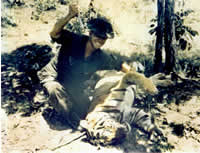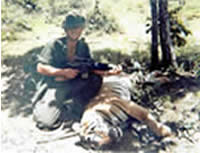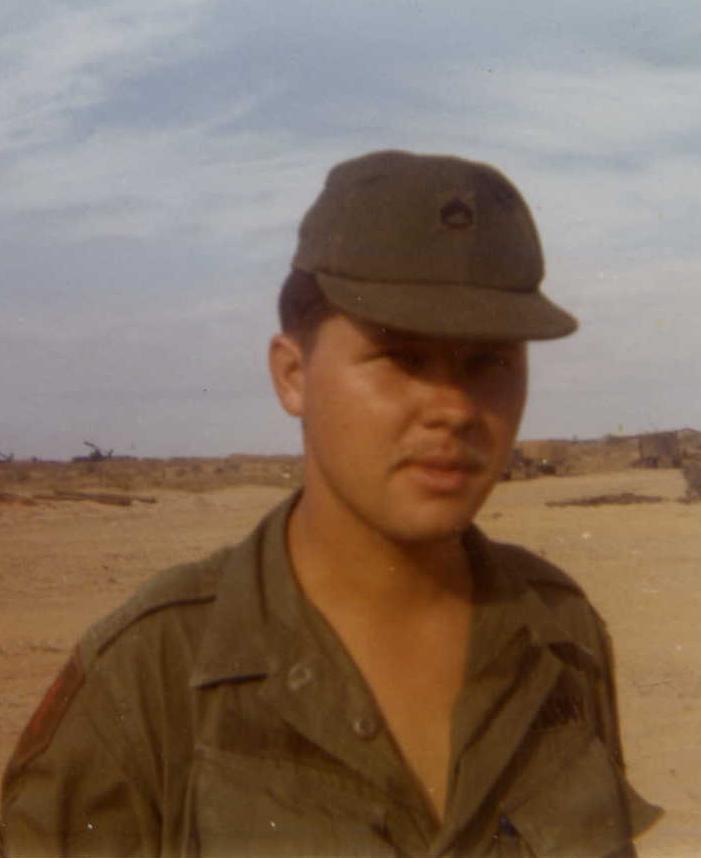Discerning the Tiger!
by Bryan Lagimoniere and Rick Leland, with John (The Mole) Williams and "B" Company Platoon Sergeant Darwin "Scott" Stamper
(Edited by Ray Sarlin)
ęCopyright Rick Leland, Scott Stamper and Bryan Lagimoniere, 2006. All Rights reserved.
(Copy permission at bottom)Webmaster's Introduction It's been said that a picture tells a thousand words. But sometimes a thousand pictures still don't tell the complete story... and this holds especially true where one of nature's most feared and photogenic creatures, the tiger, is concerned. Rick Leland and Frenchy Lagimoniere, with an assist from John Williams, give us the full picture on one such animal. |
... if some
time when roaming round, |
The Indochinese tiger (Panthera tigris corbetti) was once widely distributed throughout the forest and mountainous areas of Vietnam.
The tiger's reputation as a man-eater is often exaggerated, with only about three out of every thousand tigers ever attacking people, and then usually during retaliation in self-defence when surprised or when they are protecting cubs. But tigers that start hunting domestic animals may take a herder as victim and learn that people are easy prey or even develop a taste for human flesh.
Even the low percentage of man-eaters has been enough to make the tiger responsible for more human deaths than any other predator.
The tiger's well-known fierceness has given it a reputation throughout Asia as an aphrodisiac that is sure to get your mojo moving! In East Asia many tiger parts are considered as powerful aphrodisiacs, including bones, whiskers, fat, liver and even, or should I say especially, the tiger's penis. A bowl of tiger penis soup can fetch $350 in Taiwan and South Korea and is said to have a marvelous effect on one's virility, sexual prowess and performance. Of course, Traditional Chinese Medicine practitioners claim that their practice doesn't include animal prescriptions for sexual stamina: rather they are prescribed for ailments such as arthritis and rheumatism, to suppress pain and to reduce swelling or fevers.
In any case, since the end of the Vietnam wars, tigers have been hunted and harassed to the extent that the Vietnam government estimates that only about 200 tigers are now scattered throughout Vietnam with only about 1,700 surviving tigers in all of Asia. Hunting and trading tigers were banned in 1989, and tigers were declared a rare and completely protected species in 1992.
In fact, May 13, 2002 Agence France Presse reported the first confirmed sighting along the Sino-Vietnamese border in decades when a large tiger appeared with a roar and sent terrified villagers scurrying up trees for safety. There have been only a few scattered sightings of tigers or even tiger tracks in Vietnam since 1990.
While we all know that Vietnam was a very unusual war, I doubt that many people would believe that Vietnam's tiger population was a beneficiary. But during the Vietnam wars, it was claimed that tiger populations and tiger attacks increased dramatically due to the many unburied bodies. After all, tigers are known scavengers that feed at old kills, whether their own or not. There were also many tiger sightings by U.S. troops.
One of the most unusual tiger stories to arise was the case of the 3rd Recon Battalion Marine who survived a tiger attack while on patrol in Quang Tri Province in 1968, near where a Marine had allegedly* been killed by a tiger in November 1967. The 400 pound man-eating tiger attacked swiftly and silently, and the first warning the six-man patrol had was screaming from one of the four sleeping Marines. Startled while feeding on the man by the other Marines, the tiger started dragging its prey away before it was killed. The lucky victim was medivaced suffering lacerations and bites on the neck.
In another incident in 1969, a Marine in an ambush position in dense bush felt a tug on his leg and saw a large shape in the black night. After radioing in movement around them and despite being 100% alert, the tiger stealthily returned and grabbed another patrol member before being blown away by five excited Marines. Their buddy was released just slightly the worse for wear. According to SOP, they relocated their ambush, taking the dead 400 pound tiger with them so that they could extract it the next day. Alas, the monsoon meant that choppers couldn't get up that day, so their focus shifted to preserving the corpse before it started rotting. Fortunately, one of the fellows in the rear radioed that tannic acid, used for curing hides, was contained in urine. The next day, a very smelly carcass made it back to base still in shape for photographs.
Around the third week of May 1970, two weeks after the LZ Betty perimeter was penetrated by enemy soldiers in two places, Frenchy Lagimoniere and two other soldiers of B Company, 1st Battalion (Mechanized), 50th Infantry were assigned to pull night guard duty on Bunker 4. They manned the bunker at around 6 p.m., checked their ammunition, did their prep work and settled in for the night. At around 11 p.m., Frenchy was pulling duty and heard some noise coming from out in front of the bunker. He alerted the others and searched carefully through the starlight scope to find the source.
He remembered that night, "As I was looking for whatever made the noise a dark blur flashed in front of my lens followed by a white blur. This happened a couple of times while I was trying to get a fix on what was going on. Then I caught sight of a lizard about 6 feet long trying to scurry away from something. As I looked to my right, I saw a tiger crouched down lying in the elephant grass. Every time the lizard would move the tiger would pounce on it and slap it around like a toy animal. This happened over and over again. I pointed this out to the other guys on the bunker and we took turns watching. During the half hour this went on, others from the greenline also observed the tiger. Then it was gone."
It's a shame that the tiger hadn't come by a few weeks earlier while the NVA were sneaking up and played "cat and mouse" with Charlie.
Rick Leland of B Company now picks up the story. "A day or two later, we were on patrol in our APCs in a area of fairly heavy woods and underbrush about 25 kilometers outside of LZ Betty. Late in the afternoon our LT saw something up ahead of us and told as all to stop. I remember seeing a flash of orange and we all agreed that it was a tiger! Man, we were excited and we thought and talked about it all the rest of the day.
"That night we set out a mechanic ambush. Late that night we heard it go off, so next morning we hurried out but all we saw was a blood trail. The LT and our platoon sergeant agreed we should stick around. We patrolled in the area that day and then set out another ambush close to the last one. Well, that night we heard it go off again so the next morning one APC went out to investigate. They radioed back and said we would not believe what they had! It was the tiger, which had walked into the trip wire and been killed outright!
"Soon the word spread and we had a bunch of choppers carrying Brass and other higher ups flying in all morning long. We all took pictures and then hauled the tiger off on an APC." Frenchy added, "Everybody in the world wanted to take a picture of that cat."
John (The Mole) Williams, a B Company APC driver in the field at the time, added, "After the tiger was killed in a night claymore trip wire ambush, we wanted to take it back to base on the APC, but they made us take it off the track. By the time we got to camp dragging it with a cable or rope, all we had left was a tiger tail to talk about."
Rick observed, "I was excited and sad at the same time to see such a beautiful animal dead. It left me thinking that nothing escapes war. When I got back to States my Mother had one of the pictures blown up and I have it on my wall today."
Photographs of B Company's Tiger, 1970. (Click on photo for enlargement from Rick's photo album.)
 Rick Leland's humorous explanation. |
 Ray Wilford's version. |
 In the end, it's all the same. |
Webmaster's Addendum, 2006: Sometimes the truth comes out in a new or "fresh" viewpoint. Many of us have experienced shortfalls in accurate remembrances as the years pile up from the late 1960's and early 1970's....or, maybe the previous story ending was simply a nice "cover-up" ~Webmaster's grin~....Here's what happened to the Tiger according to "B" Company Platoon Sergeant Darwin "Scott" Stamper! |

Staff Sergeant Darwin "Scotty" Stamper |
We started using mechanical ambushes and thought they were great because we could set out a half dozen Claymore Mines on a trail and rig them to fire all at once. We could easily go somewhere and set up a night position and wait. If there was an explosion that night we could go back the next day and recover the bodies of the enemy. I can remember one night we had set out some mechanical ambushes and set up that night and waited for something to happen. Well it did! We heard an explosion in the distance and knew we had bagged something, either a VC or an animal. The next morning the platoon got up and we went out to the ambush site and found the body of a dead VC. The platoon Leader, 1st Lt. James MacQueen, and myself decided to set up another mechanical ambush around the body hoping to catch any of the dead VCs unit who might come to recover the body. We set up close by. We heard another explosion early in the morning and waited for the sun to come up. When we went in to check out the kill zone we found the body of a very large beautiful tiger! He must have decided to drag off the body of the dead VC for a snack, but he set off the ambush. There wasn┤t much damage to the pelt and it looked as though the concussion from the six Claymore Mines killed him. We put him on the front of the track behind the trimvane as you see from the pictures. We had planned to take him back with us and have a rug made out of the pelt and hang it in the club. Well, by about 10 A.M. he started getting pretty "ripe" and we did not have anyone that could dress him out, or wanted to. Just as I was considering dumping him a chopper started circling over us while we were on the move and the pilot called on our frequency and asked me if that was a tiger on the front of the APC. I told him it was and he asked me what we were going to do with it. I told him what we had planned to do with it but that it was starting to get pretty ripe. He asked me what we wanted for it and I told him he could have it for 15 cases of beer to be delivered when we got back to Phan Thiet. We made the deal and we secured an LZ and he came in and got the tiger. When we got back to the Company Area we had the 15 cases of beer waiting for us! |
Note: * Using the date given by the source document,
I tried in vain to find the name of the alleged casualty in the Casualty Database:
however, there were possibilities within several days either way (Ray).
ęCopyright Rick Leland, Scott Stamper and Bryan Lagimoniere, 2006. All Rights reserved.
Permission is hereby granted to copy this story to print or
on web pages at no charge provided the line below is included:
Reprinted from the 1st Bn (Mech) 50th Infantry website http://www.ichiban1.org/
( web sites should make the url a link or may also just link to this page )
